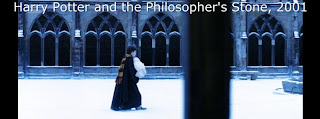Tim Tate & Michael Janis talk about the future of the arts to students at St Anthony's in Sunderland, England.
After meeting with the students, Sunderland City Council's Catherine Auld then took the DC crew on a quick jaunt to a couple of scenic spots that are around the city of Sunderland. First stop, the Town Hall and Indoor Market of Durham.
Durham Cathedral (and denim jeans artwork installation).
Catherine Auld, Kay Janis and Tim Tate at the Cathedral's famed "Sanctuary Knocker".

"Daily Bread" stained glass in Durham Cathedral by Mark Angus, 1984.


Professor Tate as Harry Potter and the Fulbright Scholar, 2012

Washington Old Hall
The Saxon Origin of the Washington Family Name: This was, in fact, where the purely Saxon name of Washington derived. Among the first to bear it were the descendants of William de Hartburn near Stockton [-on-Tees], who came to live in the manor now known as Washington Old Hall as long before as 1183.
At that time, people in England and elsewhere had no surnames as we know them today, and were most often identified by the locations in which they lived. “Washington” was one of them. The name originally meant “the estate of the Hwaes family.’ “Hwaes” in its turn was the name of a Saxon chief, while “ynga” meant “family” and “ton” - a typically Saxon suffix - stood for “estate.” These three terms were linked and given a tinge of French since, like many prominent families in England, the new Washingtons sought to identify themselves with the French Plantagenet kings who succeeded the Normans and ruled England after 1154. The result was the original form of Washington - “de Wessyngton".
Washington, DC Fulbright Scholars Tim Tate and Michael Janis pay homage to the Washington Old Hall in Durham County, UK.
Washington Old Hall was pulled down and rebuilt by the Bishop of Durham, who purchased the property from William de Wessyngton in 1613.Sadly, though, some three centuries later, it had become very dilapidated. The Hall was condemned as unfit for human habitation, and destined for demolition. It was fortunately saved from demolition by a committee specially formed to preserve it, and after thoroughgoing restoration work, the Hall was officially opened in 1955 by the then American ambassador, Winthrop W. Aldrich. Two years later, the Hall was taken over by the National Trust, an organization dedicated to preserving places of historical interest or natural beauty.
Garth Clark lecture on Ai Weiwei ceramics
The next morning, Garth Clark, noted art historian and critic - who the Washington Glass School has posted about his thoughts on the Death of Craft previously - gave a fascinating and provocative lecture about the work of Chinese bad-boy ceramic artist Ai Weiwei.
Click here to jump to first part of the Fulbright Journey blog posts.

No comments:
Post a Comment